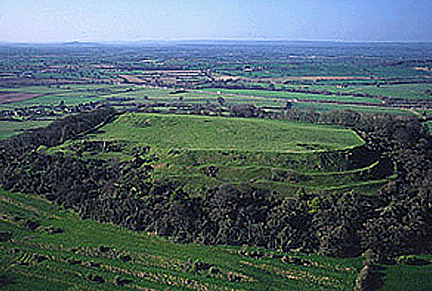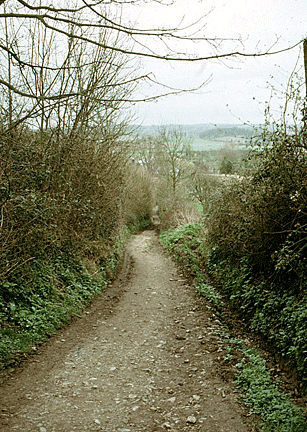|
l n
Malory's Le Morte d'Arthur, Camelot was Winchester. Local folklore says it
was Colchester. The Romans, after all, called the town Camulodunum. In both
cases, there's little to support the claim. n
Malory's Le Morte d'Arthur, Camelot was Winchester. Local folklore says it
was Colchester. The Romans, after all, called the town Camulodunum. In both
cases, there's little to support the claim.
However, the most likely site of Camelot, backed by some archaeological
evidence gathered in the 1960s, is Cadbury Castle, an Iron Age hill-fort
near Yeovil high above the plains of Somerset, near the village of Queen
Camel. John Leland, an antiquarian during Henry VIII's reign, wrote that
local people often referred to the remains of this fortified hill as "Camalat--King
Arthur's Place."
Excavations conducted by archaeologist Leslie Alcock revealed wattle and
daub huts within an 18-acre enclosure on top of the hill. Two shrines, a
metalworkers' area, furnaces, smiths' tools and finished weapons were also
unearthed. Evidence shows that the entrance to Camelot was by way of a
cobbled roadway, ten feet across, which passed through a timber-lined
passage beneath a gate-tower raised on posts and tied in with the rampart
and sentry walkway on either side. Massive pairs of doors closed off either
end of this passage. Large quantities of dressed masonry from derelict Roman
buildings formed the rampart, itself.
 From
findings near the site of Arthur's Palace, it became clear that Cadbury had
been at one time a stronghold of great importance, revamped from its
original pre-Roman state and turned into a fortress. From
findings near the site of Arthur's Palace, it became clear that Cadbury had
been at one time a stronghold of great importance, revamped from its
original pre-Roman state and turned into a fortress.
I found the lane leading up to the hilltop, which climbed gently upwards
through an avenue of majestic trees, rough underfoot. When I reached the
summit, a grassy plateau awaited me with a view to rival any in England.
There have been many ghostly sightings around Cadbury, and indeed, I felt
the coldness of spirits as I climbed around on the hollow hill. Below lay
the remains of an ancient track leading towards Glastonbury. This causeway
may have been used by Arthur and his knights traveling to and from Camelot.
Locals say that on winter nights they ride from the hill, bridles and
harness jangling, along the causeway to go hunting. Those who claim to have
seen this fearsome sight say the tips of their lances glow in the dark and
the baying of their hounds causes their spines to tingle.
With evidence that a large timber hall stood on the summit since as long as
1586, my imagination began to wander. Was this the great hall where Arthur
and his queen held their wedding feast, and where the legends of the king
and his knights were born? The romantic thought that these tales were
possibly true is what kept me on the trail of Arthur and his court.
After exploring the site of Camelot, I explored a site near Cadbury Castle,
along the banks of the River Cam on Salisbury Plain, where locals say the
Battle of Camlann took place. Farm workers once unearthed a large number of
skeletons in a mass grave west of the castle, suggesting a mighty battle
took place. I could only dream of knights in armor, the clash of their
swords sounding the spirit of defiance and justice.
Next:
The Birthplace of Arthur
|
